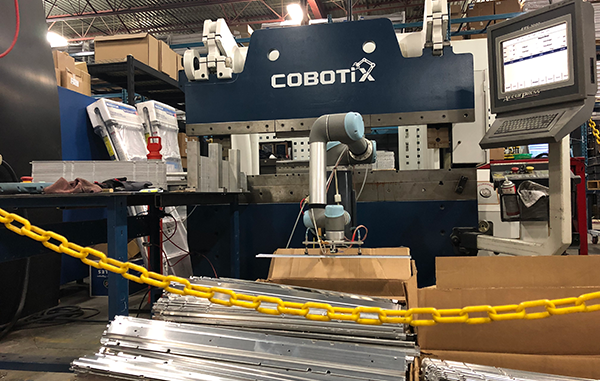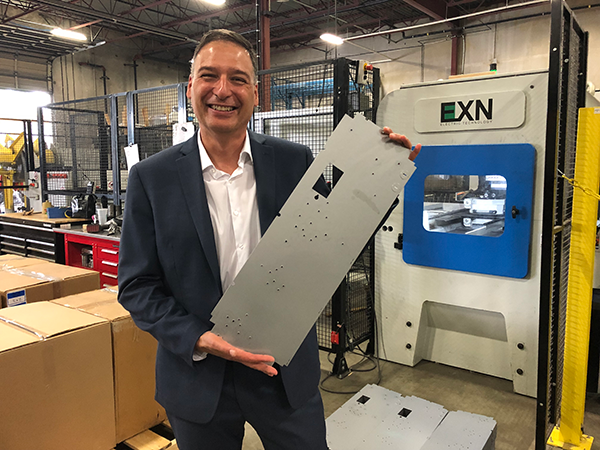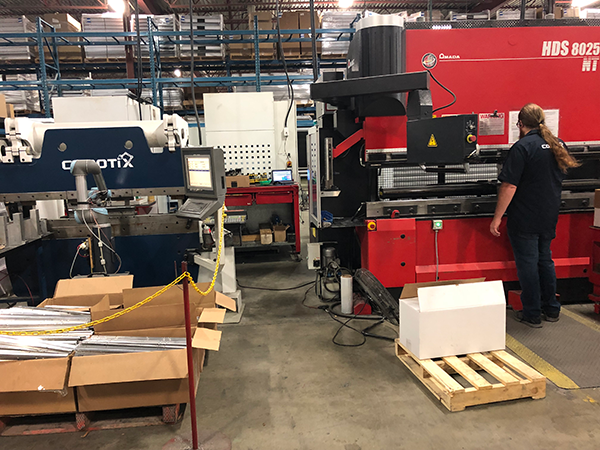
By: Rosa Diaz and Ada Slivinski • Photos courtesy of Cobotix
Automation is an inevitability in manufacturing as technology advances, and Cobotix Manufacturing in Port Coquitlam, British Columbia, is ahead of the curve when it comes to integration of staff and robots—or the collaborative robots they call cobots.
In their early days as a sheet metal fabrication shop, the company saw the waste and inefficiencies common in the industry and pivoted to embrace new technology and production methods, first integrating robots into their process about two years ago. The practice is revolutionizing the way they do business.
“Robots never tire and repeat the same operation shift after shift all year long. Set them up on Friday and come in Monday morning to a stack of parts,” said Cobotix President Ron Adolf.
For a sheet metal fabricator where time is of the essence, this means they can increase output and profits.
“That product was never touched by a human being. Since automating the manufacturing process, our customer’s price has dropped from $10 to $3.90. and Cobotix has increased its profit on every part, a real win/win for both of us,” said Cobotix COO Alex Kurilyak.
He said that as far as retaining their team, integrating robotics works out exceptionally well because it allows staff to do the more interesting, complex work instead of the risky, repetitive tasks they were charged with previously.
“A job that could be carpal-tunnel inducing, that’s repetitive, boring, or has any element of risk, a robot could do that,” said Adolf. “We’re not replacing people; we’re giving our team better and safer tools to work with. More interesting work turns into better pay. And because of the efficiencies of automation, it allows our pay scale to go up as well,” said Adolf.
And the benefits extend beyond the company to the workers. When salaries, wages and bonuses go up as well as new initiatives like profit sharing, that’s when companies can start to see even greater buy-in from their team. “If companies don’t do that [share the benefits of automation], their employees may actually try to sabotage the automation efforts,” he said.
Not only does automation speed up and add efficiencies to the manufacturing process, there are also significant safety benefits. “You cannot put a price on that,” said Adolf, “People cannot be injured anymore.”
“Having someone standing in front of a machine doing the same thing over and over again, can be a real safety concern. Some modern equipment cannot accommodate light curtains or safety devices. Robots can be an excellent solution,” said Kurilyak

Much of the work of integration and on-the-ground implementation has been done by machine shop lead Marc Saunter, who spends part of his days programming and designing automation solutions.

“We’re integrating robots to address safety, quality and efficiency,” he said.
For training, often the approach Cobotix will use is to have a robot working near a machine using traditional fabrication methods. By slowly starting to interact with the robot, staff grow more comfortable and familiar with how it works. They also lean on training videos provided by companies like Trumpf and Universal Robots as well as the assistance of a safety advisor from the Manufacturing Safety Alliance of BC.
“The Alliance knows all the regulations and standards, and you’re not afraid to open up. It’s non- intimidating,” said Saunter. “It feels like we have a partner, a safety team. It gives us far more confidence in developing our safety program and feels like we have someone really strong in our corner.”
Recently, Cobotix has set up a facility in house at Fluxwerx Illumination, a commercial lighting company in Surrey—another example of how the company innovates and stays ahead of the times. Co-locating production in the customer’s facility has eliminated a lot of traditional waste. This includes transportation and logistics costs, saving about $150,000 to $200,000 per year.
This symbiotic relationship, it is a shift from the traditional vendor/supplier relationship that can be fraught with a lot of waste and inefficiencies.
“We give our customer what they need, when they need it, eliminating excessive inventory and space” As a result, we help them be far more competitive in their market place” said Kurilyak.
The company’s five-year plan is to have manufacturing cells in Seattle, Southern California, Texas, and Atlanta, Georgia. In British Columbia, they plan to grow from two facilities to five.
“We grow together, we win together… and that’s a much more interesting place to be,” said Adolf. ■
